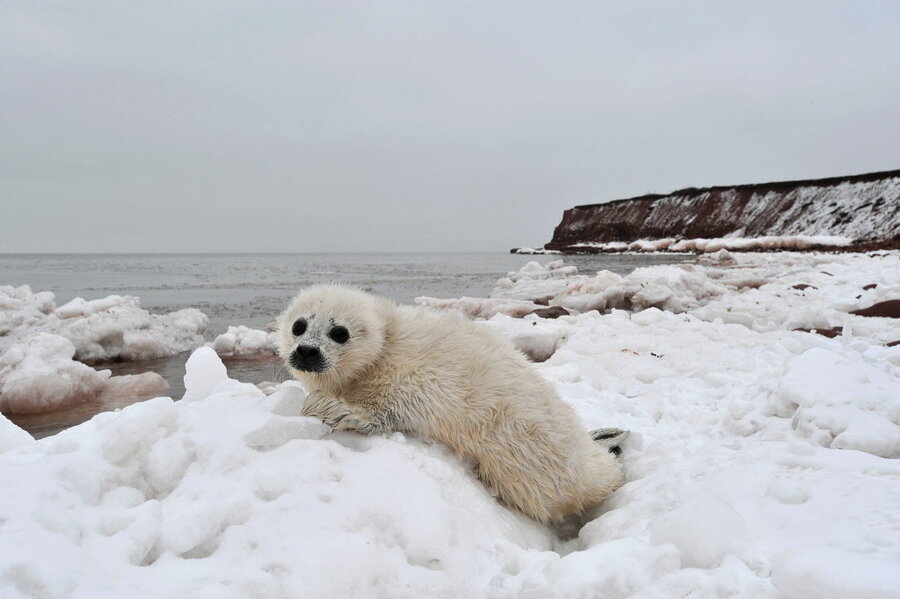Global warming could spell more bad news for baby seals
Loading...
Researchers have delivered more bad news for the harp seal – this time for male babies.
Harp seals, with their wide, amused-looking black eyes and earless, white faces, are often poster children for the toll that climate change is taking on the world. As the Arctic ice melts, the little animals are pushed off their ice breeding grounds, often becoming stranded and turning up along dead or injured the American East Coast. Now, new research shows that infant male harp seals are particularly vulnerable to those strandings.
"Changes in percent ice cover are impacting the number of strandings we are seeing," said Brianne Soulen, a biologist at the University of North Texas and co-author on the paper, published in PLOS ONE. "The inclusion of sex information allowed us to discover that males are stranding more than females."
Harp seals breed in two regions, the northwestern Atlantic near eastern Canada, and the northwestern Atlantic near the tip of far western Russia. Pups are born on ice from late February until March and are then weaned within two weeks of birth. For the following four-week period, the babies live on the ice off their fat stores. It's only after this vulnerable ice-bound period that the seals, newly puffed with their soft white coats, are prepared to hunt on their own and migrate to summer mating grounds.
But that breeding ice is melting: Studies have projected that the Arctic’s ice may recede by as much as 20 percent by 2050, with summers being ice-free by 2037. A paper published last year in PLOS ONE found that ice cover in all harp seal breeding regions is declining by as much as 6 percent per decade. As a result, since 1991 over 3,000 harp seals have been stranded along the East Coast from Maine to North Carolina, the authors report. In 2011 alone, five seals turned up in North Carolina and Virginia.
Now, scientists at Duke University have expanded previous research on seal strandings and melting ice cover to take into account biologic factors: Is one of the sexes more vulnerable to strandings than the other? Are strandings compromising genetic diversity, producing less fit seals that are in turn more susceptible to strandings?
"This is one of the first studies in this region to analyze multiple factors: sea ice, demographics, and genetics, said Kristina Cammen, a doctoral student in ecology at Duke University and a co-author on the paper. "Previous studies have analyzed the effects of sea ice or genetics independently, but our study considered multiple factors at once."
Researchers collected skin samples from 106 harp seals that were either caught or found stranded on the United States’ East Coast between 1992 and 2010. DNA was then extracted and analyzed from those skins to test for genetic variability. The stranding rates were also broken down into different demographic categories, including age and sex.
The researchers found no strong correlation between strandings and genetic diversity.
"We have shown that the genetic diversity in the population seems to be high," said Dr. Soulen. "Further research with a larger sample size would be needed to definitively determine population diversity.
But there was a significant correlation between stranding rates and both sex and age – a correlation that foretells ill for male seal pups.
During normal ice cover years, male and female seals were stranded in about equal number. In light ice years, the strandings increased for both sexes – but disproportionately so for the male seals.
That heightened rate of male seal strandings in light ice years could be related to young male seals being more exploratory than their female counterparts – less ice means that those infant explorations are more likely to go awry, said Soulen.
And young animals were also particularly vulnerable to strandings. In both normal and light ice years, younger seals were stranded at a higher rate than were adult seals, ending up tossed into the water before their six week ice nesting period had elapsed.
"When there is less ice or the ice disappears faster this can force pups into the water sooner," said Soulen. "The pups rely on an ice-based food chain which is dependent on the duration and extent of the ice."
Research on threats to harp seals joins surging attention to the effects that melting in the Arctic will have not only on the wildlife there but on the entire planet. This week, a team of researchers found that, by 2030, the release of methane gas from just the melting Arctic ice is likely to accelerate the rise in temperatures to 3.6 degrees Fahrenheit above pre-industrial levels. That increase in temperatures would cost the world some $60 trillion in damages – a sum almost as large as the size of the entire global economy last year, which measured about $70 trillion. That number tacks on an additional cost of about 15 percent to the already $450 trillion that global warming is expected to cost the world.








